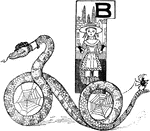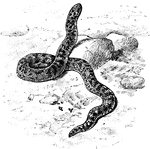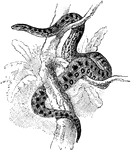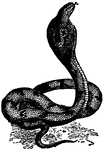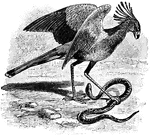
Secretary Bird
The Secretary Bird (Sagittarius serpentarius) is a bird of prey known for hunting snakes and other reptiles.
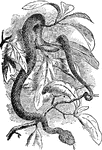
Viper
An illustration of an atheris burtoni, a species of viper. These snakes are found all over the world,…
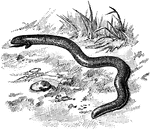
Four-Toed Worm Lizard
The four-toed worm lizard (Chirotes canaliculatus) is a reptile of the Amphisbaenidae family of usually…

Mural Frieze-like Decoration from the Temple of Esneh
They are generally of smaller dimensions in the interior, so that the walls or columns of the same chamber…
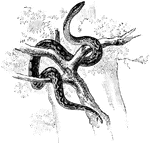
Ringed Boa
The Ringed Boa (Epicrates cenchria) is a non-venomous snake in the Boidae family of boas.
Adderstongue
Lphioglossum (adder's-tongue) is a genus of about 25-30 species of Ophioglossales in the family Ophioglossaceae,…

Mud Snake Slithering through Grass
The Mud Snake (Farancia abacura) is a reptile in the Colubridae family of colubrid snakes native to…

Seated Egyptian Figure with Hieroglyphics Pictured to the Right
An Egyptian figure wearing a headdress with a snake, is seated on a stool with an ornamental design…
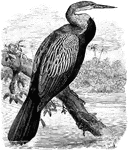
Indian Darter
"The Indian Darter (Plotus melangaster) or snake-bird of tropical and subtropical America, ranging northwards…

A Wryneck Sitting on a Tree
"Iynx torquilla, the Cuckoo's-mate or Snake-bird, is fairly common in England, and extends thence to…
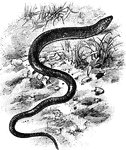
Eastern Glass Lizard
The Eastern Glass Lizard (Ophisaurus ventralis) is a legless lizard in the Anguidae family.
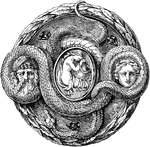
Snake Brooch
This snake brooch is designed with two figure heads on each side and a kneeling female figure in the…
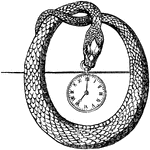
Brooch Watch
This brooch watch is designed to be pinned on a garment. It shaped in a snake that is formed into a…
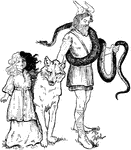
Loki and his Pets
Loki goes into Asgard with his daughter, Hela, and his pets, Jormundgand the serpent, and Fenris the…
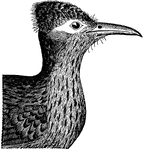
Ground Cuckoo Head
"Geococcyx californianus. Ground Cuckoo. Chaparral Cock. Road Runner. Snake Killer. Paisano. Most of…
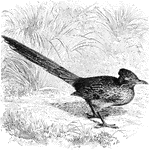
Ground Cuckoo
"Geococcyx californianus. Ground Cuckoo. Chaparral Cock. Road Runner. Snake Killer. Paisano. Most of…

Two Heads Are Better Than One
"Across the fields two travelers journey slow, / One looks around to find the distant foe; / The other…

Aegean Snake Goddess
The sculpture of an ancient Snake Goddess. The artifact demonstrates typical Minoan female attire.
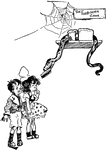
Snake Giving Two Children Cake
A cartoon of a snake feeding a piece of cake to two children. A sign over the cake reads: The Forbidden…
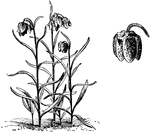
Habit and Detached Single Flower of Fritillariia Meleagris
The common name of fritillaria meleagris is common fritillary or snake's head. The flowers are checked…

Habit and Detached Flower Head of Liatris Spicata
The common names of liatris are blazing star and button snake root. The spicata variety has purple flowers…

Amorphophallus Rivieri
The common names of Amorphophallus riviera are devil's tongue and snake palm. Pictured is the flower…
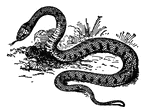
Grass Snake
Its color is olive-gray or brown above, with black bands and spots, and checkered black and white beneath.…
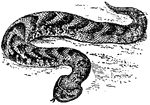
Puff-Adder
A highly poisonous African viper. It's name is derived from the habit of inflating its body when alarmed…

Bishop's Staff - Head with Serpent Design
Illustration of the head of a bishop's staff, also called a crosier. The head is a serpent curled around…

The Creation of the World - Adam and Eve, Animals, Plants,
"In the beginning God created the heavens and the earth." Genesis 1:1 ASV Illustration of God sitting…
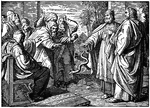
Aaron's Rod Turning into a Serpent Before Pharaoh and His Magicians
"And Moses and Aaron went in unto Pharaoh, and they did so, as Jehovah had commanded: and Aaron cast…
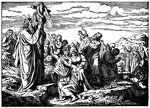
The Brazen Serpent and the Healing of the Israelites
"And Jehovah sent fiery serpents among the people, and they bit the people; and much people of Israel…
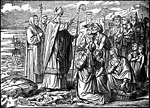
Saint Patrick Blesses the Irish and Banishes Snakes
Illustration of Saint Patrick on the shores of Ireland, with bishop's miter and crosier, and other clergy…
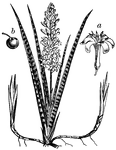
Snake Plant
Sansevieria Zeylanica is the Latin name, but this plant is also called a Mother-in-law's Tongue. "A…

King Cobra
Illustration of a King cobra, Ophiophagus elaps, also called a Shiva snake or Siva snake because it…
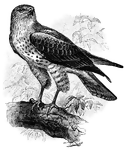
Snake Buzzard, Also Called a Short-Toed Eagle
Circaetus gallicus is a "bird of prey inhabiting all the countries bordering the Mediterranean, and…
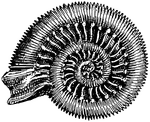
Snakestone - Ammonite
Ammonites bisulcatus. "Same as ammonite; from an old popular notion that these shells were coiled snakes…
